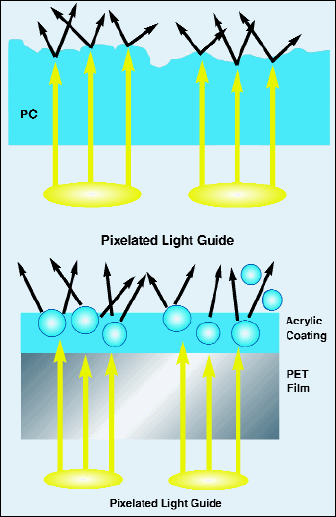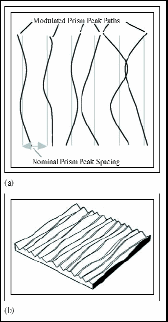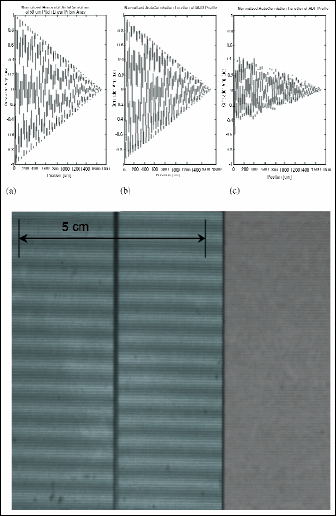Advances in LCD Backlight Film and Plate Technology
Diffusive and refractive optical films and plates are and will continue to be key elements of the LCD backlight system. The significant technical advances achieved in polymeric films or plates that diffuse and/or refract light from the light-guide plate or directly from the lamps will be explored.
by Mahari Tjahjadi, Grant Hay, Dennis J. Coyle, and Eugene G. Olczak
LIQUID-CRYSTAL-DISPLAY (LCD) backlighting systems fulfill the crucial function of delivering an evenly distributed plane of illumination to the LCD-panel assembly and contribute a significant portion of an LCD's volume, weight, power consumption, and cost. With every new model, improvements including increased luminance; viewing angle; energy efficiency and environmental reliability; smaller form factor; and lower costs through reduced part count and greater manufacturing yields are expected. New lighting technologies, such as light-emitting-diode (LED) lamps and hot-cathode fluorescent lamps (HCFLs), also bring new challenges to backlights.
Two important elements of most backlighting systems are polymeric films or plates that diffuse and/or refract light from the light- guide plate (mobile devices, laptops, and monitors) or directly from the lamps (in direct-lit applications such as LCD TVs). Significant technical advances in these two elements have been achieved and are the subject of this article.
Diffuser films are plastic films coated with microscopic polymeric particles in an acrylic coating matrix. Diffuser plates for direct-lit applications are typically composed of a resin matrix with a dispersed filler. Diffuser films and plates are necessary to eliminate non-uniformity across the face of the backlight, hide optical defects such as moiré, and provide a protective barrier to prismatic films lying beneath a top diffuser in a complete backlight assembly. Common issues with diffuser films include film distortion, which causes optical defects after long-term environmental exposure, and scratching or flaking of the coated surface. The root causes of these issues are the anisotropic nature of the multi-layer coated-film construction and the material characteristics of the coating.
Prismatic films (commonly referred to as brightness-enhancing films) are used to refract light for the purpose of collimating the light to the viewer. Prismatic films are optical devices with one side covered by a linear array of micro-prisms. These prism films are a major contributor to moiré fringes in LCDs. Several variations of these films are available and, while some deviate from perfect linearity, all are still substantially periodic and prone to moiré.
Monolithic Diffuser Technology
General Electric Co. (GE) has developed a family of Illuminexa optical diffuser film and plate technologies for LCD backlighting applications. The basic technology is a unitary monolithic film consisting of polycarbonate (PC) and a uniformly dispersed anti-static material sufficient to impact desired properties while retaining transparency (Fig. 1). The proprietary anti-static material comprises a fluorinated phosphonium sulfonate. The main advantage of a unitary Lexana (PC) film is its ability to uniformly change dimensions when exposed to any temperature or chemical potential within the operating environment.
Conventional diffuser-film products have a binary layer construction (i.e., acrylic-coated PET). The mismatch in the material properties between the PET substrate and the acrylic coating can cause physical distortion (waving), which leads to optical defects, especially subsequent to environmental exposure. This mismatch becomes even more critical as the format of the application expands, in terms of size (i.e., TVs), and the propensity of dimensional issues to result in waving and optical defects is significant, due to differences in the coefficient of thermal expansion and water expansion. In addition, PC has a significantly higher glass-transition temperature (~146°C) than PET (~70°C), inherently providing more resistance to significant thermal exposure. Figure 2 demonstrates the environmental robustness of the unitary-diffuser-film design. Permanent distortion after environmental exposure (60°C, 95% RH, 12 hours) is significant in the conventional 8-mil-coated PET binary construction and nearly absent in the 8-mil PC unitary construction.
Mahari Tjahjadi is Display & Optical Films Global Technology Leader at GE Plastics and Grant Hay is Product Technology Manager, Display & Optical Film Technology at GE Plastics, 1 Plastics Ave., Pittsfield, MA 01201; telephone 413/448-7110, e-mail: web.feedback@gep.ge.com. Dennis J. Coyle is Program Manager and Eugene G. Olczak is a Research Scientist at GE Global Research.
The GE unitary films are manufactured via an extrusion calendaring process using specialized resins. Optical additives to the resin and/or functional surface-relief textures create the optical functionality of the film. These textures are formed through replication from the tooling during the extrusion calendaring process. In this process, the molten polymer is passed through the nip of two counter-rotating rolls, which also function as the texture tooling.
Top diffuser films, whose main function is protecting the prismatic film and providing enough scattering to relieve moiré artifacts, typically do not require an optical additive. Prismatic films historically have been easy to scratch and, as a result, breakage of prism tips cause bright spots and lines. A surface-relief texture is sufficient to provide the minimal scattering that is required. These films have optical hazes of less than 50%. Bottom diffuser films typically have higher scattering power with hazes that can exceed 95% to aid in hiding artifacts from the backlight construction. Either or both of the above methods are used to achieve the optical functionality required for bottom diffusers.
In applications where there is a greater need to enhance axis luminance and manage viewing angle, a more highly engineered structure is required. Unlike the binary construction typically utilized in the marketplace, GE has developed technology for an optically functional, packed microlens structure on the film's surface with a unitary-film construction. This allows optimized on-axis and viewing-angle performance management of a binary-type film design with the environ-mental robustness advantages of the unitary-film design.1 This film is made via the extrusion calendaring process with PC-based polymers utilizing special tools and process conditions.
Beyond critical optical and environmental performance, point-defect control, UV-light resistance, and anti-static performance are achieved via material design and resin and film process optimization. Low film optical retardation (35 nm in 8 mil film) and reduced coefficient of thermal expansion (30 ppm) are achieved by specialized extrusion and calendaring processes for specific applications.

Fig. 1: Diffuser-film construction. The top illustration shows unitary film construction, while the bottom demonstrates binary film construction.
The development and application of a diverse family of monolithic unitary PC-based diffuser film and plate products has demonstrated the versatility and advantages of this approach. This technical approach is well-positioned to meet increasing technical demands for diffuser films and plates in the growing market for large LCD-TV applications.
Moiré Effects with Prismatic Films
Prismatic films are optical devices that have one side covered by a linear array of micro-prisms, typically with a pitch in the range of tens of microns for the purpose of collimating the light to the viewer. Prismatic films are a major contributor to moiré fringes in LCDs because the microstructured film and the LCD pixels all contain ordered-periodic structures. Due to the close proximity of these components, interference patterns caused by the interaction of the component-to-component microstructures can be easily observed. Several variations of these films are available today. Some of these deviate from perfect linearity, but all are still substantially periodic and prone to moiré.
The surface-relief structure of each component can result in illumination variations (or shadows) that echo the surface topology. Consider the interaction between a prismatic film and LCD pixels. The prismatic features produce intensity fluctuations or shadows that can change form and intensity as a function of viewer location. The LCD pixel array can be described as having a mask function due to its pattern of optical transmission. The interaction of these components is best understood in the frequency domain. The frequency content of the incident intensity fluctuations convolved with the Fourier transform of the mask function results in many spatial frequencies that can produce fringes due to the replicant (or aliased) spectra of the ordered pixel array. The visible fringes that are observed are an aliasing effect commonly referred to as moiré fringes (or just moiré).
The typical approach to eliminating moiré is to add a diffuser-film component between the components that support the interaction. The light-scattering property of a diffuser provides optical blurring between the interfering components. An important attribute of a diffuser is the lack of an ordered structure, which prevents the diffuser itself from contributing to moiré. The drawback of using a diffuser is that frontal luminance is reduced by the scattering and the need for the additional component(s).
The moiré frequencies due to a periodic prism film (or other periodic microstructured film) are given as
Fm = m/Pp - 1/Pf , (1)
where Pp is the LCD pixel pitch in the direction under analysis (vertical or horizontal), Pf is the pitch of the prisms, and m is an integer. The period that corresponds to each frequency is given by Pm = |1/Fm|. Of particular interest is the lowest aliased frequency since this replicant will typically be the replicant that is observable.
Fig. 2: Environmental robustness of binary and unitary diffuser films. (a) PET-based binary film construction. (b) PC-based unitary film construction.

Fig. 3: (a) Overhead view and (b) 3-D rendering of modulated prism paths.
Given two displays that exhibit moiré effects of equal proportions, if one exhibits this effect with higher-frequency artifacts, it may be viewed as superior in quality. This is because if the frequency is sufficiently high, the moiré is more difficult for the human eye to observe. If the prism film is rotated relative to the pixel structure, the pitch of the prism array will seem to increase as a function of the rotation angle. This effective pitch can be used in Eq. (1) to estimate the moiré fringe frequency.
Modulated Surface-Relief Structures
The technology introduced here provides an alternative to the conventional approach of adding additional space and diffuser films when designing high-performance illumination systems that are free from moiré fringe effects. The innovation is a type of surface structure with the performance benefits of precision micro-optics but without the ordered properties that contribute to moiré fringes.2,3
Figure 3 illustrates the concept of modulated prism paths. The view shown is normal to the plane of the display. Here, the gray vertical lines represent the location of vertically oriented prisms in a linear array. The black lines show how a small sample of the prism peak locations might by changed relative to the linear array. Note that each is varying independently. The frequency with which the modulation changes in the vertical direction affects the appearance of the pattern (graininess). Also, the blur function of the film is modified by the modulation. Due to the various modulation paths in the randomized structure introduced here, there is an additional component to the blur function caused by curvature of the paths. Generally, increasing slope in the path increases blur. Thus, this new film structure combines both collimation and diffusion.
Moiré Performance Metrics: Autocorrelation Length
The autocorrelation function, cf (x), is commonly used in surface metrology to categorize the surface topology.4
 (2)
(2)
Here,
x is a distance along the surface traversing the prismatic structure. The autocorrelation function always has a maximum value at
cf (
x) = 0. It is characteristic of random surfaces, such as diffusers, that
cf (
x) will rapidly attenuate as
x increases. For purely periodic surfaces,
cf (
x) will oscillate to its maximum value at an interval that corresponds to the nominal period of the structure. This occurs for integration over negative infinity to positive infinity; finite profiles of periodic surfaces will have similar oscillations in
cf (
x) that taper off linearly to zero at a length that is equal to that of the sample.
One way to quantify the randomness of a surface is by using the autocorrelation length (Lc), which is the distance from x at which cf(x) first decreases below a threshold that is a fraction of cf (x) at x = 0, typically e-1 (0.37). Generally, the shorter the correlation length, the more random the surface will be. For a surface whose topography consists of pure white noise, cf (x) reduces to a delta function and Lc = 0.
To determine if the modulation applied to a surface design is causing the surface to be more random (hence, less periodic and prone to moiré), the autocorrelation function is a useful tool. This is illustrated in Figs. 4 and 5. In Figs. 4(a) – 4(d), four surface-height maps are shown for modulated prism surface samples that are 1700 μm2. Here, the gray-scale value of each image corresponds to height of the surface (in microns). From these figures, the standard deviation of the modulation of each surface is increasing.
In Fig. 4(a), the surface map appears to be nearly linear with little interruption in the vertically oriented microprisms. The autocorrelation function of this surface is highly oscillatory with little difference from the linear fall-off; this is to be expected due to a finite sample of a purely periodic profile. Proceeding from (a) to (d) in Fig. 4, each subsequent surface appears to be visibly more random and the autocorrelation function of each drops off more rapidly. The autocorrelation function in Fig. 5 (d) has a very short autocorrelation length compared with that of Fig. 5 (a), and the correspondingly aggressive modulation is apparent in the surface height map shown in Fig. 4 (d).

Fig. 4: Modulated surface-height maps as modulation is increased.
Experimental Results
A modulated film structure with a nominal pitch of 37 μm is shown in Fig. 6. Here, nonlinearity in the prismatic structures due to the modulation is easily visible.
The benefit of the modulated structure in a typical LCD is shown in Fig. 7. For this comparison, a single horizontal prism film was placed above the bottom diffuser on the backlight, the stock top diffuser was removed, and the pattern was photographed through an LCD panel with a pixel pitch of 254 μm. The photos were shot in a side-by-side configuration so that lighting and contrast were the same for all films. Images (a) and (b) show a competitor's offerings. Image (c) shows the same ADF film as characterized in Fig. 6. In all cases, the rotation of each film is approximately 0°
Figure 7 illustrates the potential reduction in moiré fringes by modulation of the prism structure. As shown by the autocorrelation function, samples in (a) and (b) have periodic structures with periodic ringing and an envelope with linear taper from unity. The height modulation in (b) does not eliminate periodicity. Such periodic structures can produce strong moiré fringes via interaction with the pixels. In contrast, the use of modulated prism structures eliminates the periodicity as indicated by the immediate drop in the autocorrelation function to values of about 0.3–0.4. The corresponding dramatic reduction in moiré fringes is shown in Fig. 7(c).
Use of modulated prismatic structures does not necessarily imply reduced frontal luminance, even though the modulation in itself introduces moiré-reducing and blurring properties in the film. Choice of materials can have a significant effect on luminance. Desired properties are low haze and high refractive index. Two films were measured. The first was a conventional linear array of prisms of refractive index 1.59 on a base film of PET (haze ~0.5%). The second was a modulated prism array of refractive index 1.61 on a PC-based film (haze ~0.15%).
The luminance was measured for both in a two-film crossed configuration, typical of notebook and cell-phone LCD film stacks. The latter film shows dramatic reduction in moiré fringes while having an on-axis luminance 7% higher than the linear array with no loss of luminance in the relevant viewing angle, as measured by a Microvision SS220 system.
Conclusions
Diffusive and refractive optical films and plates are and will continue to be key elements of the LCD backlight system. Market trends for larger, thinner, brighter, and more-durable displays coupled with continuous cost challengesdrive the need for innovation in these products.
GE has developed Illuminexa modulated prismatic films that are not periodic, resulting in drastically reduced moiré. Adding moiré-reducing modulation along with diffusion functionality does not necessarily compromise brightness. High-refractive-index low-haze materials result in a film-stack brightness higher than that of conventional linear periodic prism films, and with no observable moiré.
Prism films for LCD backlights are but one potential application of this technology. Virtually all prismatic arrays used in backlighting and front-lighting systems can benefit from this technology. For example, light-guide plates and turning films can be made using this random modulated microstructure technology. The combination of these can result in backlights with even higher brightness with no observable moiré.

Fig. 5: Plots (a) through (d) are plots of the autocorrelation function for a cross section of each of the surfaces shown above each in Figs. 4(a) – 4(d).

Fig. 6: SEM of a modulated prism structure.
References
aIlluminex and Lexan are trademarks of the General Electric Co.
1Bastawaros, et al., "Light-collimating and diffusing film and system for making the film," U.S. Patent No. 7092163 (2006).
2E. G.. Olczak, "Optical structure and method of making," U.S. Patent No. 6862141 (2005).
3E. G. Olczak, "Optical structure and method of making," U.S. Patent No. 2005/0225865 (2005).
4D. J. Whitehouse, Handbook of Surface Metrology (Rank Taylor Hobson, Ltd., 1999). •

Fig. 7: Moiré fringe is eliminated by the use of modulated prisms. Comparison of auto-correlation functions (top) and moiré fringes (bottom) for two films from an other manufacturer [(a) and (b)] and GE ADF [(c)].